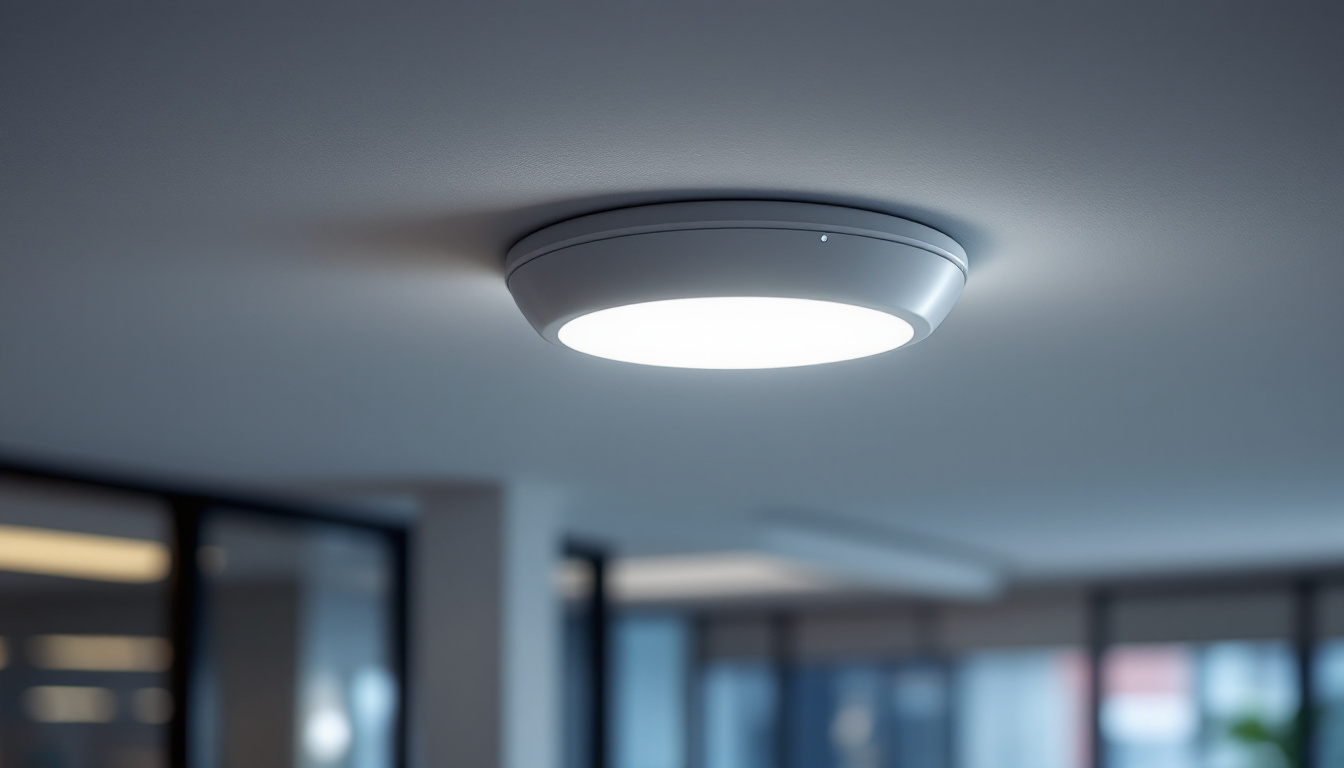

The lighting industry is undergoing a significant transformation, driven by advancements in technology and a growing emphasis on energy efficiency. Among the innovations that are making waves is the ceiling mount occupancy sensor. This device is not just a trend; it represents a fundamental shift in how lighting is controlled and managed in various environments. For lighting contractors, understanding the implications and benefits of these sensors can lead to enhanced project outcomes and satisfied clients.
Ceiling mount occupancy sensors are devices designed to detect the presence of people within a designated area and control lighting accordingly. By utilizing various technologies, such as passive infrared (PIR) and ultrasonic sensors, these devices can accurately determine occupancy levels and adjust lighting in real-time. This capability not only improves energy efficiency but also enhances user experience in commercial and residential spaces. In addition to lighting control, these sensors can also be integrated with HVAC systems, allowing for optimized climate control based on occupancy, further contributing to energy savings and comfort.
The operation of ceiling mount occupancy sensors is based on detecting motion or heat signatures. PIR sensors, for example, identify changes in infrared radiation emitted by people. When an individual enters a room, the sensor detects this change and activates the lighting. Conversely, when the room is unoccupied for a predetermined period, the lights automatically turn off, conserving energy. This automatic adjustment not only reduces electricity costs but also extends the lifespan of lighting fixtures by minimizing unnecessary usage.
Ultrasonic sensors, on the other hand, emit sound waves and measure the reflection of these waves to detect movement. This technology is particularly effective in spaces with obstacles, as it can detect even subtle movements. By combining these technologies, ceiling mount occupancy sensors can provide comprehensive coverage and reliable performance in various environments. Moreover, advanced models can be programmed with different sensitivity settings, allowing users to customize the responsiveness of the sensors based on specific needs, such as high-traffic areas versus quieter spaces.
There are several types of ceiling mount occupancy sensors available, each designed to meet specific needs. Some common types include:
Choosing the right type of sensor depends on the specific application and the layout of the space. Understanding these options allows lighting contractors to tailor solutions that best meet their clients’ needs. For instance, in large warehouses or manufacturing facilities, dual technology sensors may be preferred to ensure comprehensive coverage, while in smaller offices, a simple PIR sensor may suffice. Additionally, some sensors come equipped with daylight harvesting capabilities, which adjust lighting based on the amount of natural light available, providing an even greater level of energy efficiency and comfort.
Implementing ceiling mount occupancy sensors in lighting systems offers numerous advantages. These benefits extend beyond mere convenience, impacting energy savings, user satisfaction, and overall system efficiency.
One of the most significant benefits of ceiling mount occupancy sensors is their ability to reduce energy consumption. By automatically turning off lights in unoccupied spaces, these sensors can lead to substantial savings on electricity bills. In commercial settings, where lighting can be a major expense, the impact of these savings can be particularly pronounced.
Furthermore, many jurisdictions are increasingly implementing energy efficiency regulations, making the installation of occupancy sensors not just beneficial but often necessary. Lighting contractors who incorporate these technologies into their projects can help clients comply with these regulations while also enhancing their operational efficiency.
Ceiling mount occupancy sensors also contribute to a better user experience. By ensuring that lights are only on when needed, these sensors create a more comfortable environment. In workplaces, this can lead to increased productivity, as employees are less likely to be distracted by flickering lights or the need to manually adjust lighting levels.
In residential settings, homeowners benefit from the convenience of automatic lighting. Whether entering a room with hands full or navigating through dark hallways, the presence of occupancy sensors enhances safety and ease of movement.
Another advantage of ceiling mount occupancy sensors is their potential to extend the lifespan of lighting fixtures. By reducing the amount of time lights are on, these sensors minimize wear and tear, leading to fewer replacements and maintenance costs over time. This not only benefits the client financially but also contributes to sustainability efforts by reducing waste.
The versatility of ceiling mount occupancy sensors makes them suitable for a wide range of applications across different industries. From commercial to residential settings, these sensors can be integrated into various lighting systems to enhance efficiency and user experience.
In commercial environments, such as offices, retail stores, and warehouses, ceiling mount occupancy sensors can significantly improve energy management. In open office layouts, for instance, these sensors can help maintain optimal lighting levels based on occupancy, ensuring that lights are only on when employees are present.
Retail spaces can also benefit from these sensors by creating a more inviting atmosphere. By ensuring that lights are automatically adjusted based on foot traffic, retailers can enhance the shopping experience while managing energy costs effectively.
Schools and universities can leverage ceiling mount occupancy sensors to create conducive learning environments. Classrooms, hallways, and common areas can be equipped with these sensors to ensure that lighting is only active when students and staff are present. This not only saves energy but also fosters a more focused atmosphere for learning.
In healthcare settings, the importance of lighting cannot be overstated. Ceiling mount occupancy sensors can help maintain appropriate lighting levels in patient rooms, waiting areas, and hallways. By ensuring that lights are only on when needed, these sensors contribute to patient comfort and reduce energy consumption in facilities that often operate around the clock.
For lighting contractors, understanding the installation process and considerations for ceiling mount occupancy sensors is crucial. Proper installation ensures optimal performance and reliability, which in turn leads to satisfied clients.
One of the most critical factors in the effectiveness of ceiling mount occupancy sensors is their placement. Properly positioning the sensors can maximize coverage and minimize blind spots. Factors such as ceiling height, room layout, and potential obstructions should be taken into account during installation.
Contractors should also consider the field of view of the sensor. For example, a PIR sensor typically has a limited range and may not detect movement in corners or behind furniture. In such cases, using multiple sensors or combining different types of sensors can enhance coverage.
Ceiling mount occupancy sensors can often be integrated into existing lighting control systems. This integration allows for more sophisticated control strategies, such as dimming lights based on occupancy levels or scheduling lighting based on time of day.
Contractors should assess the compatibility of the sensors with existing systems and provide clients with clear guidance on how to optimize their lighting control strategies. This not only enhances the functionality of the lighting system but also adds value to the overall installation.
Once the installation is complete, educating clients about the operation and benefits of ceiling mount occupancy sensors is essential. Providing training on how to adjust settings, troubleshoot issues, and understand the energy savings can empower clients to make the most of their new systems.
By equipping clients with knowledge, contractors can foster long-term relationships and ensure that clients feel confident in their investment in smart lighting technology.
As the lighting industry continues to evolve, the role of ceiling mount occupancy sensors is expected to expand further. With the rise of smart buildings and the Internet of Things (IoT), these sensors will play a crucial role in creating interconnected environments that optimize energy use and enhance user experiences.
Future developments may see ceiling mount occupancy sensors integrated with other smart technologies, such as building management systems and smart home devices. This integration will enable more advanced functionalities, such as remote monitoring and control, predictive maintenance, and data analytics.
Lighting contractors who stay ahead of these trends and embrace new technologies will be well-positioned to offer innovative solutions to their clients. Understanding how to integrate occupancy sensors with other smart technologies will be a valuable skill in the evolving landscape of lighting design.
As sustainability becomes increasingly important across industries, the demand for energy-efficient solutions will continue to grow. Ceiling mount occupancy sensors align perfectly with this trend, offering a straightforward way to reduce energy consumption and lower carbon footprints.
Contractors who advocate for the use of these sensors not only contribute to their clients’ sustainability goals but also position themselves as leaders in the industry. By promoting energy-efficient solutions, contractors can differentiate themselves in a competitive market.
Ceiling mount occupancy sensors are undeniably a game-changer for the lighting industry. Their ability to enhance energy efficiency, improve user experience, and extend the lifespan of lighting fixtures makes them an essential component of modern lighting design. For lighting contractors, understanding the benefits, applications, and installation considerations of these sensors is crucial for delivering exceptional solutions to clients.
As the industry continues to evolve, embracing the potential of ceiling mount occupancy sensors will not only benefit contractors but also contribute to a more sustainable and efficient future for lighting. By staying informed and adapting to new technologies, lighting professionals can ensure they remain at the forefront of this exciting transformation.
Ready to harness the power of ceiling mount occupancy sensors and revolutionize your lighting projects? At LumenWholesale, we provide you with the highest quality, spec-grade lighting solutions at unbeatable wholesale prices. Say goodbye to inflated markups and hello to superior products that meet the most rigorous industry standards. With our hassle-free bulk buying and free shipping, you can equip your projects with the best value lighting without any hidden fees. Elevate your lighting game and experience the ultimate in quality, affordability, and convenience. Visit LumenWholesale today and take the first step towards a brighter, more sustainable future.

Discover the essential insights every lighting contractor needs to know about fluorescent lights, from energy efficiency and installation tips to troubleshooting common issues.

Discover essential insights and expert tips for lighting contractors in “Lamp Post: Lighting Contractors Should Know.” This article delves into the latest trends, technologies, and best practices in the industry, ensuring your projects shine brightly and efficiently.

Discover essential insights for lighting contractors on optimizing stairway and corridor illumination.

Discover essential insights into architectural gooseneck and barn lights with our comprehensive guide for lighting contractors.
Get notified when NEW deals are released.
Optimize your budget with wholesale discounts.
Only top-quality, specification-grade lighting products.
No additional costs at checkout - what you see is what you pay.
We understand the unique needs of contractors.